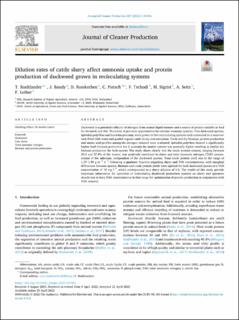Please use this identifier to cite or link to this item:
https://doi.org/10.21256/zhaw-25622Full metadata record
| DC Field | Value | Language |
|---|---|---|
| dc.contributor.author | Stadtlander, Timo | - |
| dc.contributor.author | Bandy, Jaclyn | - |
| dc.contributor.author | Rosskothen, Dennis | - |
| dc.contributor.author | Pietsch-Schmied, Constanze | - |
| dc.contributor.author | Tschudi, Fridolin | - |
| dc.contributor.author | Sigrist, Mathias | - |
| dc.contributor.author | Seitz, Andreas | - |
| dc.contributor.author | Leiber, Florian | - |
| dc.date.accessioned | 2022-09-12T08:50:48Z | - |
| dc.date.available | 2022-09-12T08:50:48Z | - |
| dc.date.issued | 2022 | - |
| dc.identifier.issn | 0959-6526 | de_CH |
| dc.identifier.uri | https://digitalcollection.zhaw.ch/handle/11475/25622 | - |
| dc.description.abstract | Duckweed is a potential collector of nitrogen from animal liquid manure and a source of protein suitable as feed for livestock and fish. Therefore, it provides opportunities for circular economy systems. Two duckweed species, Spirodela polyrhiza and Landoltia punctata, were grown in five recirculating systems each connected to a reservoir tank filled with water and graded organic cattle slurry concentrations. Fresh and dry biomass, protein production and amino acid profiles among the nitrogen removal were evaluated. Spirodela polyrhiza showed a significantly higher fresh biomass production but L. punctata dry matter content was generally higher resulting in similar dry biomass production for both species This study shows clearly that the crude protein content, ranging between 29.3 and 37.9% of dry matter, was positively correlated to slurry and total ammonia nitrogen (TAN) concentration of the substrate, independent of the duckweed species. Total crude protein yield was in the range of 1.37–1.95 g m−2 d−1, following a quadratic function regarding slurry and TAN concentrations, with marginal differences between species. Biomass and crude protein yields were optimal for both duckweed species at a TAN concentration of 19 mg l−1, which corresponded to a slurry dilution of 1:8. The results of this study provide important information for operation of recirculating duckweed production systems on slurry and operators should aim to keep TAN concentrations in that range for optimization of protein production in conjunction with TAN removal. | de_CH |
| dc.language.iso | en | de_CH |
| dc.publisher | Elsevier | de_CH |
| dc.relation.ispartof | Journal of Cleaner Production | de_CH |
| dc.rights | https://creativecommons.org/licenses/by-nc-nd/4.0/ | de_CH |
| dc.subject | Duckweed | de_CH |
| dc.subject | Cow slurry | de_CH |
| dc.subject | Total ammonia nitrogen | de_CH |
| dc.subject | Biomass and protein production | de_CH |
| dc.subject.ddc | 639.8: Aquakultur | de_CH |
| dc.title | Dilution rates of cattle slurry affect ammonia uptake and protein production of duckweed grown in recirculating systems | de_CH |
| dc.type | Beitrag in wissenschaftlicher Zeitschrift | de_CH |
| dcterms.type | Text | de_CH |
| zhaw.departement | Life Sciences und Facility Management | de_CH |
| zhaw.organisationalunit | Institut für Umwelt und Natürliche Ressourcen (IUNR) | de_CH |
| dc.identifier.doi | 10.1016/j.jclepro.2022.131916 | de_CH |
| dc.identifier.doi | 10.21256/zhaw-25622 | - |
| zhaw.funding.eu | No | de_CH |
| zhaw.issue | 131916 | de_CH |
| zhaw.originated.zhaw | Yes | de_CH |
| zhaw.publication.status | publishedVersion | de_CH |
| zhaw.volume | 357 | de_CH |
| zhaw.publication.review | Peer review (Publikation) | de_CH |
| zhaw.webfeed | Aquakultur-Systeme | de_CH |
| zhaw.funding.zhaw | Nachhaltig produzierte Wasserlinsen als mögliche neue Proteinquelle für die Aquakultur | de_CH |
| zhaw.author.additional | No | de_CH |
| zhaw.display.portrait | Yes | de_CH |
| Appears in collections: | Publikationen Life Sciences und Facility Management | |
Files in This Item:
| File | Description | Size | Format | |
|---|---|---|---|---|
| 2022_Stadtlander-etal_Dilution-rate-cattle-slurry-duckweed.pdf | 3.17 MB | Adobe PDF |  View/Open |
Show simple item record
Stadtlander, T., Bandy, J., Rosskothen, D., Pietsch-Schmied, C., Tschudi, F., Sigrist, M., Seitz, A., & Leiber, F. (2022). Dilution rates of cattle slurry affect ammonia uptake and protein production of duckweed grown in recirculating systems. Journal of Cleaner Production, 357(131916). https://doi.org/10.1016/j.jclepro.2022.131916
Stadtlander, T. et al. (2022) ‘Dilution rates of cattle slurry affect ammonia uptake and protein production of duckweed grown in recirculating systems’, Journal of Cleaner Production, 357(131916). Available at: https://doi.org/10.1016/j.jclepro.2022.131916.
T. Stadtlander et al., “Dilution rates of cattle slurry affect ammonia uptake and protein production of duckweed grown in recirculating systems,” Journal of Cleaner Production, vol. 357, no. 131916, 2022, doi: 10.1016/j.jclepro.2022.131916.
STADTLANDER, Timo, Jaclyn BANDY, Dennis ROSSKOTHEN, Constanze PIETSCH-SCHMIED, Fridolin TSCHUDI, Mathias SIGRIST, Andreas SEITZ und Florian LEIBER, 2022. Dilution rates of cattle slurry affect ammonia uptake and protein production of duckweed grown in recirculating systems. Journal of Cleaner Production. 2022. Bd. 357, Nr. 131916. DOI 10.1016/j.jclepro.2022.131916
Stadtlander, Timo, Jaclyn Bandy, Dennis Rosskothen, Constanze Pietsch-Schmied, Fridolin Tschudi, Mathias Sigrist, Andreas Seitz, and Florian Leiber. 2022. “Dilution Rates of Cattle Slurry Affect Ammonia Uptake and Protein Production of Duckweed Grown in Recirculating Systems.” Journal of Cleaner Production 357 (131916). https://doi.org/10.1016/j.jclepro.2022.131916.
Stadtlander, Timo, et al. “Dilution Rates of Cattle Slurry Affect Ammonia Uptake and Protein Production of Duckweed Grown in Recirculating Systems.” Journal of Cleaner Production, vol. 357, no. 131916, 2022, https://doi.org/10.1016/j.jclepro.2022.131916.
Items in DSpace are protected by copyright, with all rights reserved, unless otherwise indicated.